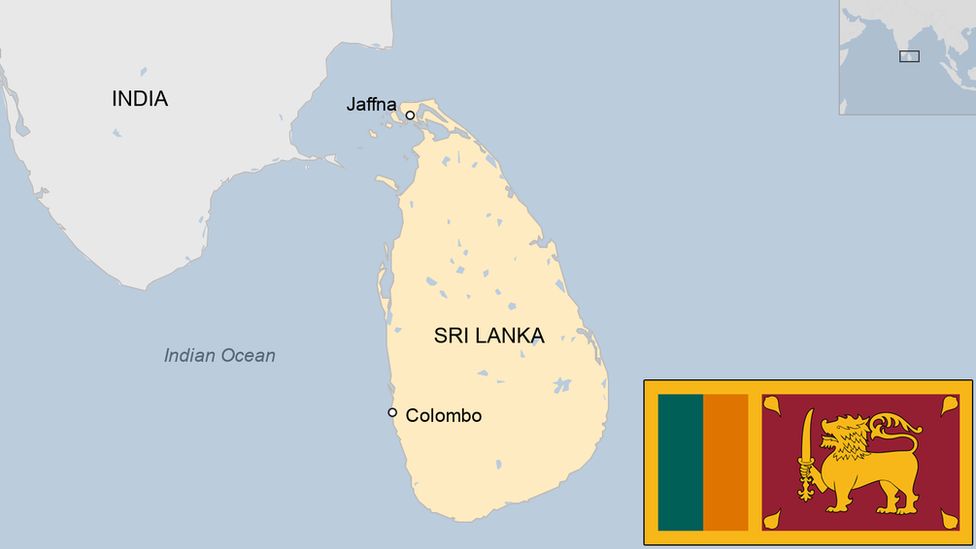Sri Lanka country profile
- Published

Lying off the southern tip of India, the tropical island of Sri Lanka has attracted visitors for centuries with its natural beauty.
But it has been scarred by a long and bitter civil war arising out of ethnic tensions between the majority Sinhalese and the Tamil minority in the north and east.
After some 26 years of violence the conflict ended in May 2009, when government forces seized the last area controlled by Tamil Tiger rebels. But recriminations over abuses by both sides continue.
The island fell under Portuguese and Dutch influence after the 16th Century. It gained independence in 1948, after nearly 150 years of British rule.
In 2022, an economic crisis led to the collapse of Sri Lanka's currency and rising inflation. This has triggered political protests and a humanitarian crisis due to a severe shortage of goods.
- Read more country profiles - Profiles by BBC Monitoring
DEMOCRATIC SOCIALIST REPUBLIC OF SRI LANKA: FACTS
- Capital: Sri Jayawardenepura Kotte (legislative) Colombo (executive and judicial)
- Area: 65,610 sq km
- Population: 22.1 million
- Languages: Sinhala, Tamil, plus English
- Life expectancy: 73 years (men) 80 years (women)
LEADER
President: Ranil Wickremesinghe
The 73-year-old former prime minister Ranil Wickremesinghe was appointed prime minister again in May 2022, this time by his sometime political rival President Gotabaya Rajapaksa.
The president hoped the appointment of the veteran politicians would help stabilise the economy and end mass anti-government protests, but Mr Rajapaksa was forced to leave the country two months later and parliament chose Mr Wickremesinghe as his successor.
The new president faces the task of negotiating international financial assistance to help the country out of a serious economic crisis, as well as restoring public order.
MEDIA
Sri Lanka's media divide along language and ethnic lines.
Many of the major press and broadcasting outlets are state-owned.
TIMELINE
Some key dates in Sri Lanka's history:
1505 - Portuguese arrive in Colombo, marking beginning of European interest.
1658 - Dutch force out Portuguese and establish control over whole island except central kingdom of Kandy.
1796 - Britain begins to take over island.
1815 - Kingdom of Kandy conquered. Britain starts bringing in Tamil labourers from southern India to work in tea, coffee and coconut plantations.
1833 - Whole island united under one British administration as Ceylon.
1948 - Ceylon gains full independence.
1949 - Indian Tamil plantation workers disenfranchised, the start of a wave of Sinhalese nationalism which alienates the Tamil minority.
1956 - Solomon Bandaranaike elected on wave of Sinhalese nationalism. Sinhala made sole official language and other measures introduced to bolster Sinhalese and Buddhist sentiment.
1972 - Ceylon becomes a republic and changes its name to Sri Lanka. Buddhism is given primary place as the country's religion, further antagonising Tamil minority.
1976 - Liberation Tigers of Tamil Eelam (LTTE) founded to fight for Tamil rights.
1983 - Start of civil war.
1987 - Government forces push LTTE back into northern city of Jaffna. Government signs accords creating new councils for Tamil areas in north and east and reaches agreement with India on deployment of Indian peace-keeping force.
1990 - Indian troops leave after getting bogged down in fighting in north. Violence between Sri Lankan army and separatists escalates.
Thousands of Muslims are expelled from northern areas by the LTTE.
1991 - LTTE implicated in assassination of Indian premier Rajiv Gandhi in southern India.
1993 - President Premadasa killed in LTTE bomb attack.
1995-2001 - War rages across north and east. Tigers bomb Sri Lanka's holiest Buddhist site. Suicide attack on the international airport destroys half the Sri Lankan Airlines fleet.
2002 - Government and Tamil Tiger rebels sign a ceasefire.
2003 - Tigers pull out of talks. Ceasefire holds.
2004 - More than 30,000 people are killed when a tsunami, massive waves generated by a powerful undersea earthquake, devastate coastal communities.
2006 - Tamil Tiger rebels and government forces resume fighting in the north-east in worst clashes since 2002 ceasefire. Government steadily drives Tamil Tigers out of eastern strongholds over following year.
2008 - Government pulls out of 2002 ceasefire agreement, launches massive offensive.
2009 - Government declares Tamil Tigers defeated after army forces overrun last patch of rebel-held territory in the northeast. Some 70,000-80,000 people are estimated to have been killed in the war.
2016 - Government acknowledges for the first time that some 65,000 people are missing from its 26-year war with the Tamil Tiger rebels and a Marxist insurrection in 1971.
2019 - Jihadist suicide bombers attack churches and hotels on Easter Sunday, killing more than 350 people.
2022 - Protesters force President Gotabaya Rajapaksa out of office during an economic crisis.
- Published21 March 2023
- Published21 March 2023
- Published15 March
- Published8 January
- Published21 March 2023
- Published16 October 2023